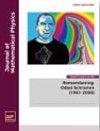Locally-homogeneous Riemann-Cartan geometries with the largest symmetry group
IF 1.4
3区 物理与天体物理
Q3 PHYSICS, MATHEMATICAL
引用次数: 0
Abstract
The symmetry frame formalism is an effective tool for computing the symmetries of a Riemann-Cartan geometry and, in particular, in metric teleparallel geometries. In the case of non-vanishing torsion in a four dimensional Riemann-Cartan geometry, the Minkowski geometry is the only geometry admitting ten affine frame symmetries. Excluding this geometry, the maximal number of affine frame symmetries is seven. A natural question is to ask what four dimensional geometries admit a seven-dimensional group of affine frame symmetries. Such geometries are locally homogeneous and admit the largest isotropy group permitted, and hence are called maximally isotropic. Using the symmetry frame formalism to compute affine frame symmetries along with the additional structure of the torsion tensor, we employ the Cartan-Karlhede algorithm to determine all possible seven-dimensional symmetry groups for Riemann-Cartan geometries.具有最大对称群的局部均质黎曼-卡尔坦几何图形
对称框架形式主义是计算黎曼-卡尔坦几何对称性的有效工具,特别是在度量远平行几何中。在四维黎曼-卡尔坦几何中扭转不相等的情况下,闵科夫斯基几何是唯一允许十个仿射框架对称的几何。除去这个几何,仿射框架对称的最大数目是七个。一个自然而然的问题是,有哪些四维几何包含七维仿射框架对称群。这样的几何图形是局部均质的,并且允许最大的各向同性群,因此被称为最大各向同性几何图形。利用对称框形式主义计算仿射框对称性以及扭转张量的附加结构,我们采用 Cartan-Karlhede 算法来确定黎曼-卡尔坦几何的所有可能的七维对称群。
本文章由计算机程序翻译,如有差异,请以英文原文为准。
求助全文
约1分钟内获得全文
求助全文
来源期刊

Journal of Mathematical Physics
物理-物理:数学物理
CiteScore
2.20
自引率
15.40%
发文量
396
审稿时长
4.3 months
期刊介绍:
Since 1960, the Journal of Mathematical Physics (JMP) has published some of the best papers from outstanding mathematicians and physicists. JMP was the first journal in the field of mathematical physics and publishes research that connects the application of mathematics to problems in physics, as well as illustrates the development of mathematical methods for such applications and for the formulation of physical theories.
The Journal of Mathematical Physics (JMP) features content in all areas of mathematical physics. Specifically, the articles focus on areas of research that illustrate the application of mathematics to problems in physics, the development of mathematical methods for such applications, and for the formulation of physical theories. The mathematics featured in the articles are written so that theoretical physicists can understand them. JMP also publishes review articles on mathematical subjects relevant to physics as well as special issues that combine manuscripts on a topic of current interest to the mathematical physics community.
JMP welcomes original research of the highest quality in all active areas of mathematical physics, including the following:
Partial Differential Equations
Representation Theory and Algebraic Methods
Many Body and Condensed Matter Physics
Quantum Mechanics - General and Nonrelativistic
Quantum Information and Computation
Relativistic Quantum Mechanics, Quantum Field Theory, Quantum Gravity, and String Theory
General Relativity and Gravitation
Dynamical Systems
Classical Mechanics and Classical Fields
Fluids
Statistical Physics
Methods of Mathematical Physics.
 求助内容:
求助内容: 应助结果提醒方式:
应助结果提醒方式:


